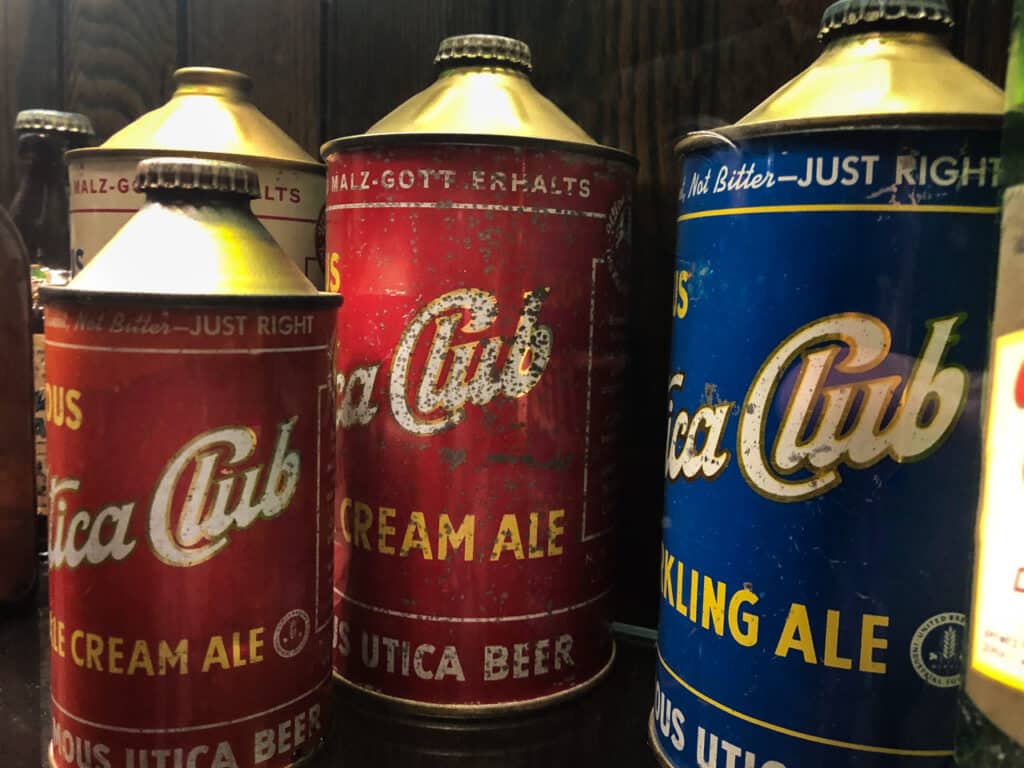
The Galliano Club Thrillers is a series of four novels set in upstate New York. Readers will step back in time to 1926 and the era of Prohibition. And while the novels are fiction, the places and characters ring true. This is because the setting, the fictional city of Lido, is based on author Carmen Amato‘s hometown of Rome, NY.
Some storylines are spun from notes Amato’s grandfather kept when he was a Prohibition-era Oneida County sheriff. The main cast of characters are members of the Italian immigrant community, many of whom work at Lido Premium Copper and Brass Rolling Mill, a mirror image of real-life Revere Copper & Brass.
Readers should dive into the series with Road to the Galliano Club. The prequel introduces the main characters and tells how they ended up in Lido: Handsome Luca Lombardo immigrated from Calabria, Italy. Ruth Cross found her way there via the vaudeville circuit. Benny Rotolo, a gangster, fled Chicago with a price on his head. Benny thinks Lido is “duller than dishwater” but sees the potential to make his fortune in bootlegging. Each character arrives in Lido with secrets and hope for a better life.
What I loved about the novels was the familiarity. Like the author, my hometown is Rome and like Luca Lombardo, my ancestors immigrated from Southern Italy. Once they hit Ellis Island, they kept going until they settled in Rome, where my great-grandfather Leonardo worked at Revere Copper & Brass.
Readers who are familiar with Rome and other upstate towns will be delighted by references to local places. For some, Amato retains the original name. For example, the Galliano Club—which the novels revolve around—is still in existence in Rome.
Other place names are fictional but derived from once thriving businesses. Like the Candyland Supper Club, a stylish destination where Luca takes his love interest Tess for a fancy night out. Candyland was an actual restaurant (though not a supper club) in downtown Rome that opened in 1921. It stayed in business for 50 years, long enough to employ my own mother, who was a waitress there in the 1960s.
There are other true-to-life references in the characters. A Deputy Sheriff by the name of Joe Sestito, who was the author’s grandfather, makes an appearance in Revenge at the Galliano Club. And anyone familiar with local pop culture in the 1960s will laugh out loud at the names given to a pair of detectives from the Lido Police Department.

If, after you read the historical thriller series and you want to capture some of the essence of old Rome, which Amato creates in Lido, you’re in luck! Because so many details are rooted in fact, readers can capture the spirit of Prohibition-era upstate New York by following the recommendations below. Read on for a travel guide to the Galliano Club Thrillers.
Get Your Groceries at a Market in Little Italy

In the novels, Amato transports us to East Lido. The two-story Galliano Club takes up half a block on fictional Hamilton Street, which is populated with shops and stalls that sell fresh fish and produce.
Former Broadway chorus girl Ruth Cross has moved into an apartment above the Galliano Club and savors what she calls the “noisy energy” of the Italian neighborhood. On a morning excursion, she sets out with her basket over her arm and fills it with fresh trout and produce, and pastries from Bella Napoli. The businesses display signs in both English and Italian.
Today, Rome’s Little Italy runs along East Dominick Street. It is unfortunately no longer a bustling thoroughfare full of shops owned by immigrant entrepreneurs, but a few Italian businesses do remain. If you’re in the neighborhood and would like to capture the essence of old Rome, be sure to stop at Rocco Gualtieri Market. The store originally opened on East Dominick Street in 1902 by an immigrant from southern Italy.
That market closed in the 1990s but Rocco’s great-grandson David Gualtieri has since reopened it, remodeling it to look as it did in 1929. David runs the shop much as Rocco did more than a century ago-and perhaps as Ruth would have experienced it. The homemade pasta and Italian sausage, the provolone and salamis, and the old-world decor all come together to set a pleasantly nostalgic scene.
- Rocco Gualtieri Market: 294 East Dominick St., Rome, NY
Eat Italian Food in Upstate New York

If East Lido is the heart of the Galliano Club novels, the food is the soul! Luca, who is employed at the Galliano Club, can often be found making sandwiches to feed the hungry mill workers after their shifts. His sandwich ingredients vary but are always irresistible.
There’s salami with provolone and roasted red peppers or spicy soppresata topped with provolone and pickled onions, and my favorite to fantasize about: figgy balsamic vinegar drizzled over mozzarella and prosciutto di parma. The fillings are always held in place with fresh crusty bread.
On her website, the author helpfully provides recipes for Luca’s unforgettable sandwiches. (See photo above for my attempt at “The Napoli!”)
There are also Sunday dinners prepared by Rosaria, Luca’s cousin’s wife. They are the simple yet filling dishes that are familiar to so many Italian Americans: linguine covered in rich tomato sauce, breaded pork cutlets, lasagna made with layers of sausage, pepperoni, and cheese.
Every dish our characters indulge in come from Amato’s personal experience. And if you know anything about Central New York’s culture, you know the food scene is still front and center. While you can easily find simple meals of pasta and marinara, the cuisine has evolved since the 1920s.

Local dishes inspired by old-world cuisine include favorites like chicken riggies and Utica Greens. Amato has mentioned Grande’s in Rome and Alteri’s in Clinton as some of her local favorites for Italian food. I second those and also add Georgio’s Village Cafe in New Hartford and Chesterfield’s Tavolo in Utica.
- Grande’s Pizzeria: 1111 Floyd Ave., Rome, NY
- Alteri’s Restaurant: 7 College St., Clinton, NY
- Georgio’s Village Cafe: 62 Genesee St., New Hartford, NY
- Chesterfield’s Tavolo: 131 N. Genesee St., Utica NY
Indulge in Pasticciotti and Other Pastries

How I wish Bella Napoli existed in real life! It’s East Lido’s local pastry shop, where Bruno the waiter only speaks Italian and where Luca takes Tess on their first date. They flirt over coffee and cannoli and their shared love of number puzzles.
It’s also a stop on Ruth’s morning shopping excursion, where she buys her pasticciotti. I loved coming across the mention of pasticciotti here. The chocolate cream-filled tarts are a beloved Central New York delicacy and for me, the Galliano Club marks the first time I’ve read about them in literature.
Known fondly by locals as pusties, these pastries are available at a handful of bakeries in Utica. Florentine and Caruso’s, located near each other on Bleecker Street, are longstanding favorites. You’ll find cannoli and more Italian sweets at both.
For a café with a neighborhood vibe in Rome, head to Coppercino’s for coffee and espresso drinks and a variety of irresistible pastries. They also serve breakfast and lunch, including a selection of to-go lunch boxes.
- Florentine Pastry Shop: 667 Bleecker St., Utica, NY
- Caruso’s Pastry Shop: 707 Bleecker St., Utica, NY
- Coppercino’s Bistro, Bakery, & Coffee: 254 W. Dominick St., Rome, NY
Drink a Utica Club, the First Beer Served After Prohibition
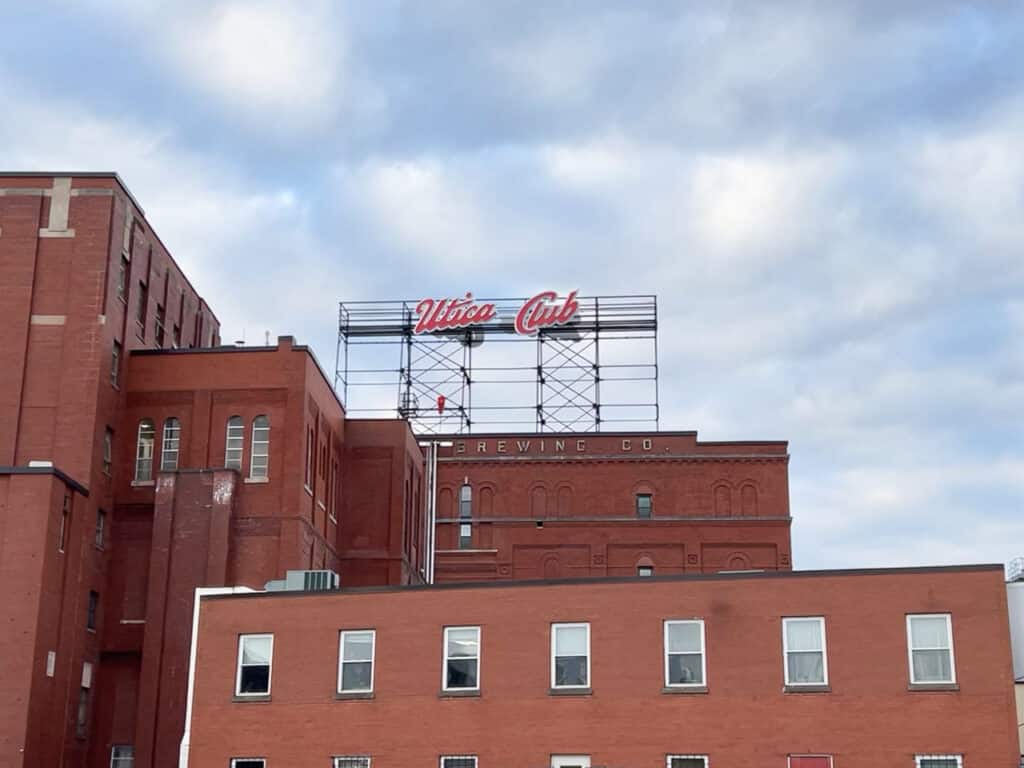
It goes without saying that a Prohibition-era novel set in Central New York would mention Utica Club beer and the brewery that produced it. The author uses the true-to-life original name, West End Brewery, as the brewery that supplies the Galliano Club with a legal, low alcohol beer and fizzy drinks like the lemon-lime rickey that’s favored by Luca.
A German immigrant named FX Matt founded the West End Brewery in 1888 in Utica. When Prohibition set in in 1920, the brewery stayed in business by producing soft drinks and non-alcoholic malt tonics. Once the ban on alcohol was repealed in 1933, West End Brewery was the first to obtain a license to sell beer, making Utica Club the first beer sold in the nation after Prohibition.
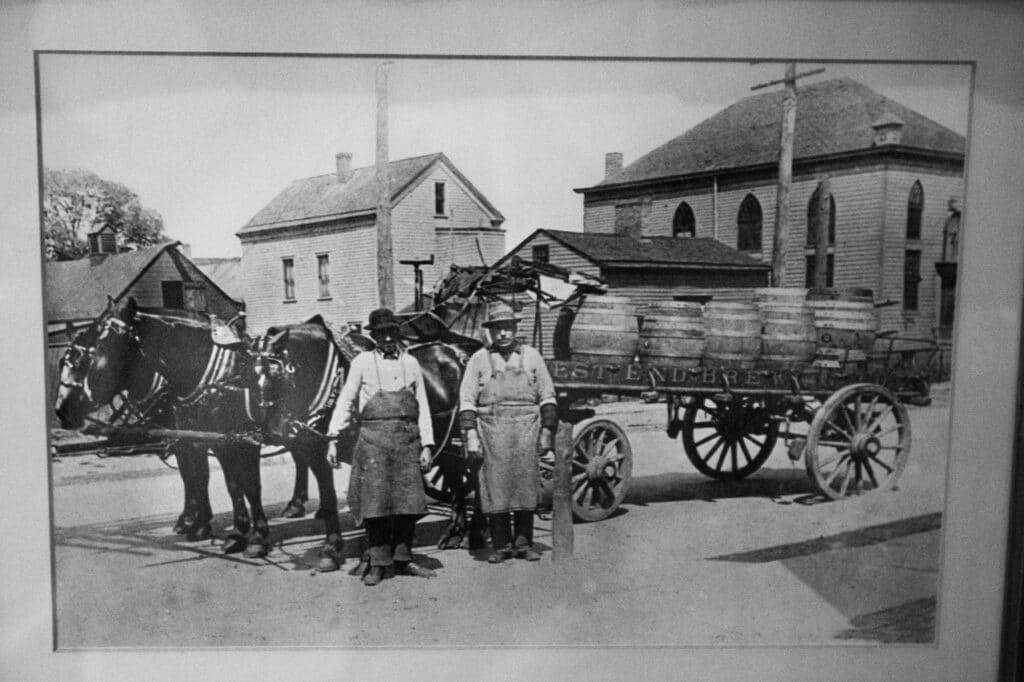
The brewery has undergone a few name changes throughout its 136-year existence, though it is still run by descendants of FX Matt. Now known as Saranac Brewing Co., the longstanding Utica business still produces Utica Club beer, though their Saranac brand—which includes IPAs, Pale Ales, Lagers, and seasonal brews like Blueberry Blonde Ale—has surpassed Utica Club in popularity. They also make a line of non-alcoholic beverages called 1888 Soft Drinks, which area based on their original West End Brewery recipes.
Step back in time to this Prohibition-era brewery to get a sense of the world our fictional Lido characters inhabited. Visitors today can order a Utica Club or Saranac beer on tap in the 1888 Tavern or order the same in the outdoor Biergarten. Both are seasonal so please check hours before you go.
- Saranac Brewing Co.: 830 Varick St., Utica, NY
See a Show at the Elegant Stanley Theatre
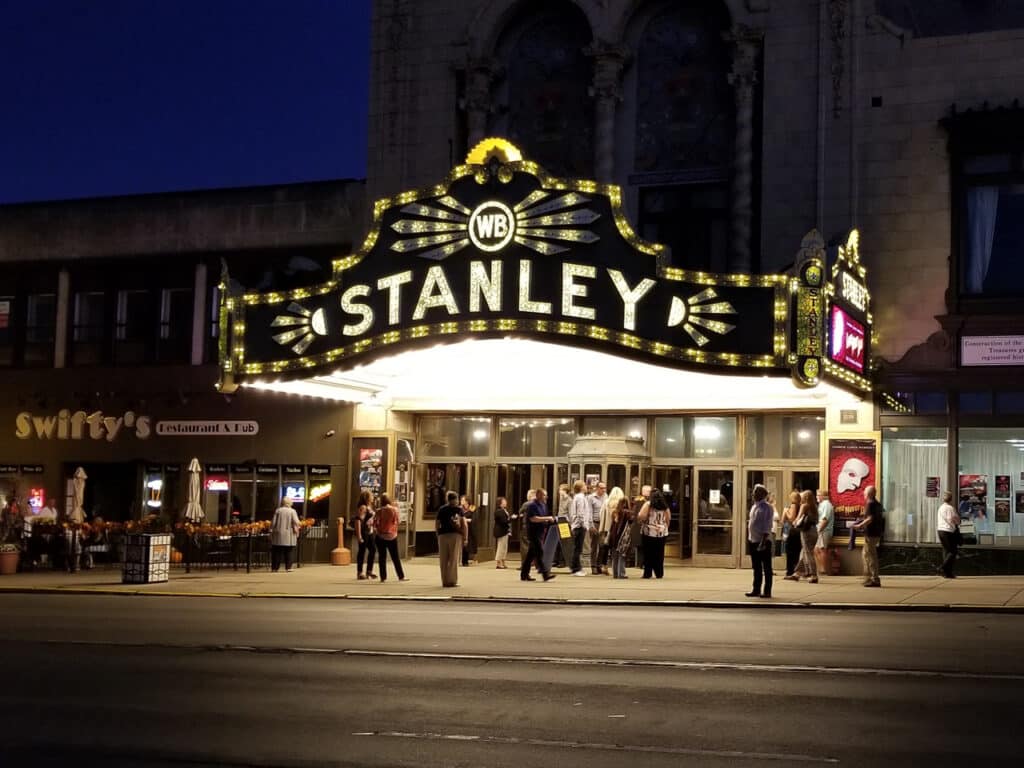
The Stanley Theatre in Utica opened its doors in 1928, two years after we leave our friends in Lido, so the theater itself does not make an appearance in the novels. However, Amato’s private tour of the theater inspired the character of Ruth Cross and her Tapping Toes School of Dance, which Ruth opened above the Galliano Club.
Originally built as a grand movie palace with nearly 3,000 seats, the Stanley Theatre now features plays, musicals, stand-up comedy, and live concerts. It is one of the gems of Utica and Upstate New York, and if you’re in the area and there’s a performance on, I highly recommend adding to your list!
If you do, you’ll have the chance to see the beautiful 1920s architecture, including a lobby staircase that replicates the stairs on the Titanic.
- Stanley Theatre: 259 Genesee St., Utica, NY
Walk or Bike the Mohawk River Trail
In the Galliano Club’s Lido, the Mohawk River is the site of many a nefarious activity. Without giving too much away, we readers find ourselves there more than once, witnessing activities that would put several of our characters in jail for a good long stretch.
Rome, as does Lido, sits on the Mohawk River in Central New York. In contrast to being the scene of a crime, the real-life riverbank provides a pleasant path for walkers and bicyclists. The Mohawk River Trail begins at Bellamy Harbor Park at the south end, which is also where the greater Empire State Trail crosses the Erie Canal.
The trail travels north along the river for almost three miles. Following the river, the paved trail makes its way across Rome, crossing East Dominick Street and passing local landmarks and businesses along the way. The trail ends at Haselton-Wright Park. The Mohawk River Trail is perfect for a leisurely walk or bike ride and is one of the most pleasant and scenic things to do in Rome.
- Bellamy Harbor Park: 139 E. Whitesboro St., Rome, NY
- Haselton-Wright Park: 200 Riverview Pkwy, Rome, NY
Take a Stroll in Vogel Park
In the Galliano Club novels, Lido’s upper crust live on West Park Circle, an upscale neighborhood situated around an expansive city park. The descriptions of stately West Park Circle and those who are wealthy enough to live there serve as a direct contrast to East Lido’s streets cluttered with immigrant shops and tenement housing.
Amato’s inspiration for West Park Circle was Vogel Park, which uniquely sits in the middle of a traffic circle on North George Street in Rome’s Historic District. Like the fictional West Park, Vogel Park is surrounded by some of Rome’s most beautiful homes. The park has provided Romans with a green space since it was created in 1919.
- Vogel Park: 1300 N. George St., Rome, NY
See Gothic Mausoleums at Historic Rome Cemetery
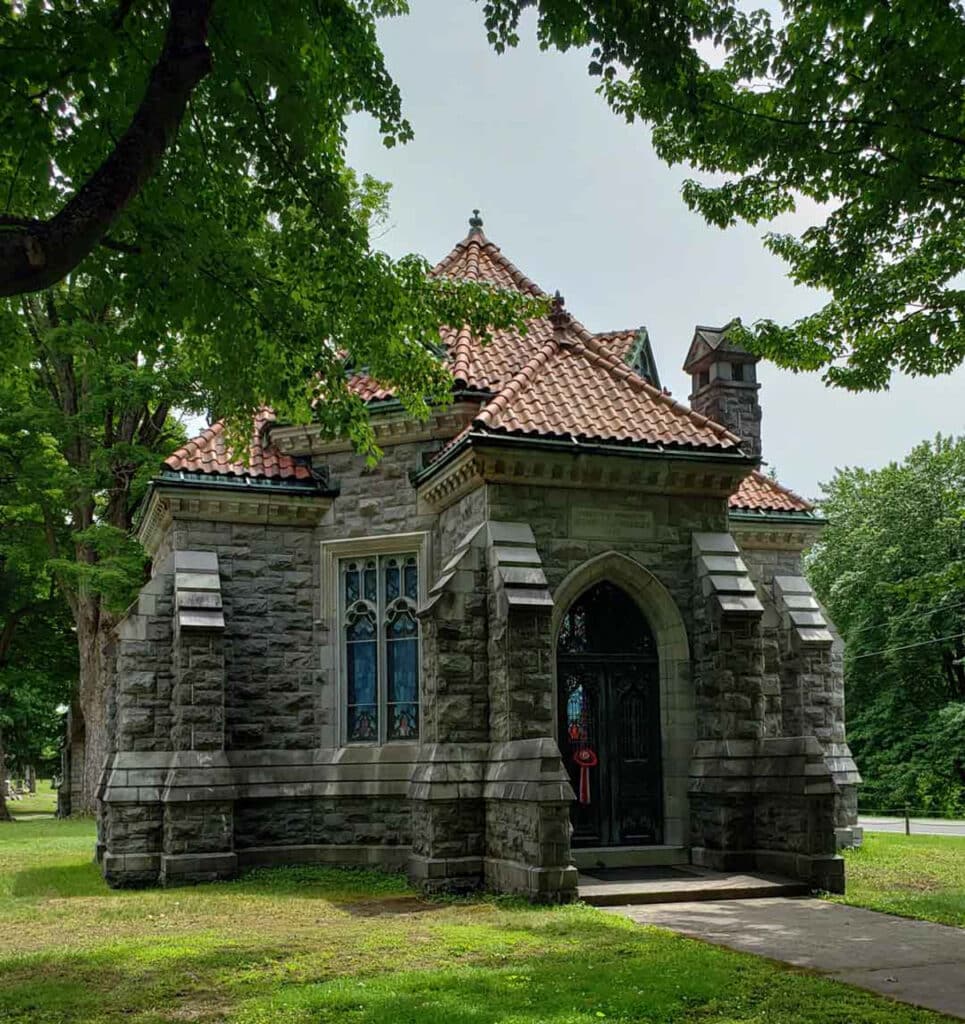
The Gothic mausoleums at the old Settlers Rest cemetery make a somewhat sinister appearance in Blackmail at the Galliano Club. Or maybe they just appear sinister to Owen Forbes Fisher, the shady accountant for Lido Premium Copper, who has gotten himself tangled up with Benny Rotolo and his Tommy gun-carrying goons. As Fisher drives through the cemetery, the burial chambers only emphasize the possibility of his demise as he drives to meet his dangerous associate.
To see the inspiration for Settlers Rest, take a walk in Rome Cemetery, which has been laying residents to rest since its first internment in 1853. The cemetery, with its Gothic mausoleums and beautifully carved tombstones, is the final resting place for many prominent Romans. Francis Bellamy, author of the Pledge of Allegiance, is probably the most recognizable name. Others include a formerly enslaved woman named Henrietta Bowen and John B. Jervis, an Erie Canal engineer. Civil War and Revolutionary War veterans are also laid to rest here.
- Rome Cemetery: 1500 Jervis Ave., Rome, NY
Soak in the Healing Waters of Saratoga Springs
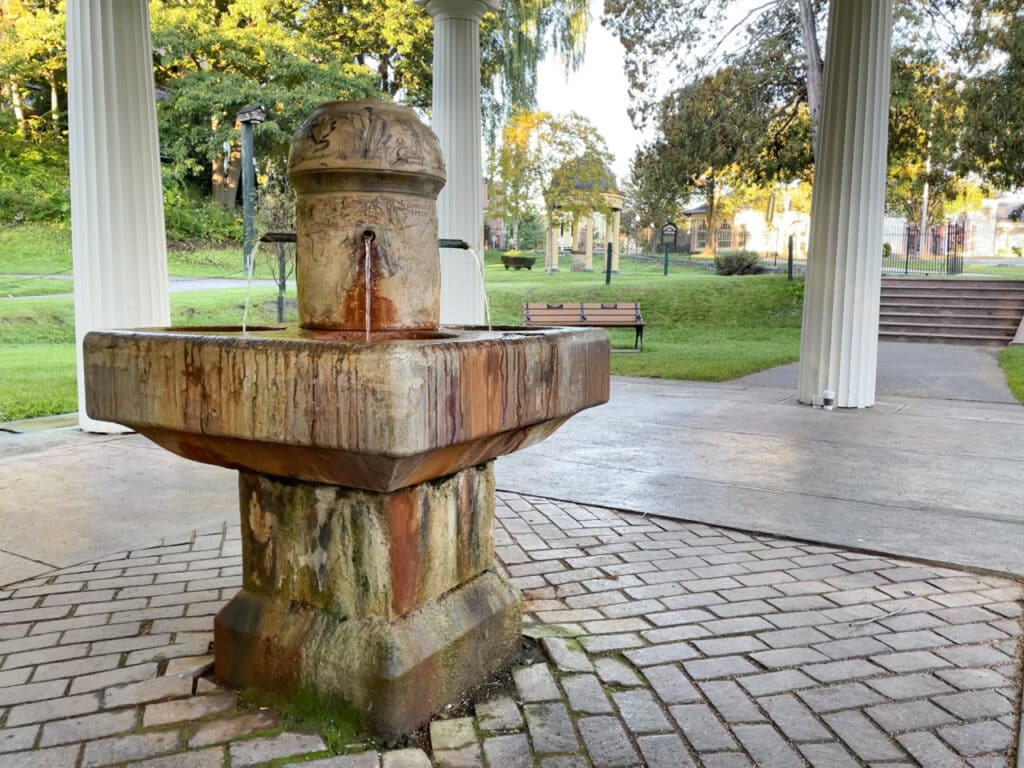
Near the end of Murder at the Galliano Club, Tess, Luca’s love interest, is planning a trip to Saratoga Springs. Tess’s Aunt Evelyn is unwell, and her doctors have suggested she “take the cure” in of the natural mineral water spas that were once so prolific that the city was nicknamed “Queen of Spas.”
Wealthy people in poor health flocked to Saratoga Springs to take advantage of the healing waters that sprung from the ground. The waters are a result of the city’s location on a geological fault line that causes underground streams to mix with minerals and gases. The waters, loaded with nutrients, then bubble up to the earth’s surface. Beginning in the 19th century, spas were built to harness these healing mineral waters.
Visitors to Saratoga Springs, located about 100 miles east of Rome, can still experience this unique healing water. It runs from fountains and faucets in the city parks and, in the case of the Geyser Island Spouter, even spouts up on its own from a mineral-rich island in the middle of a stream in Saratoga Spa State Park.
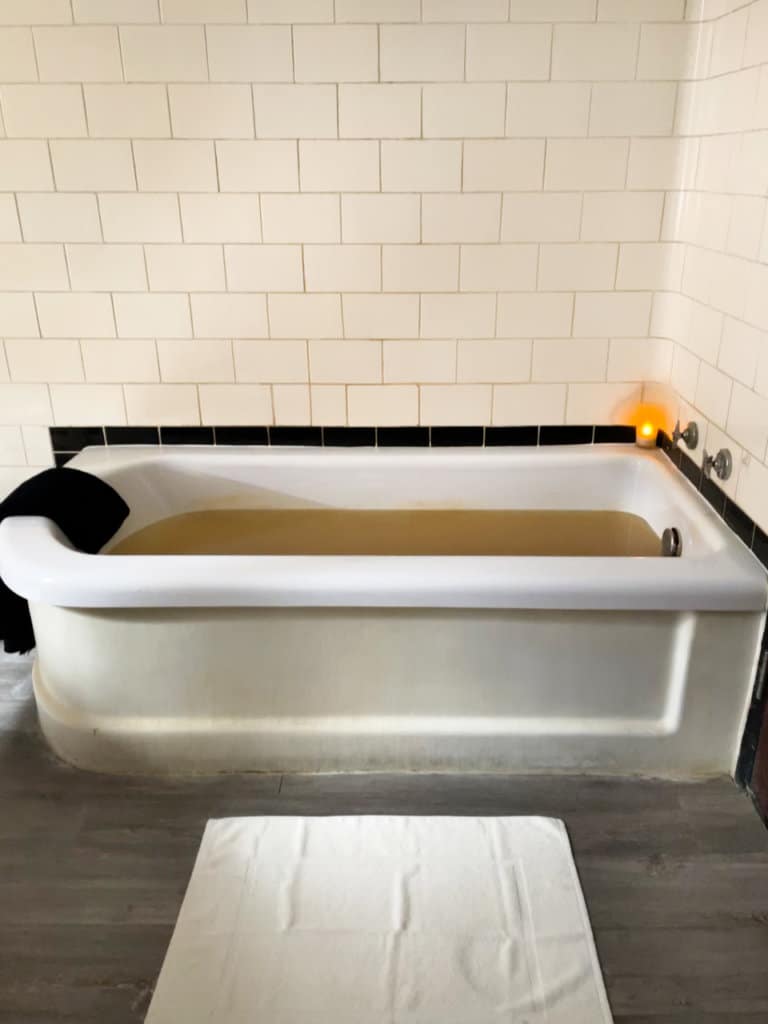
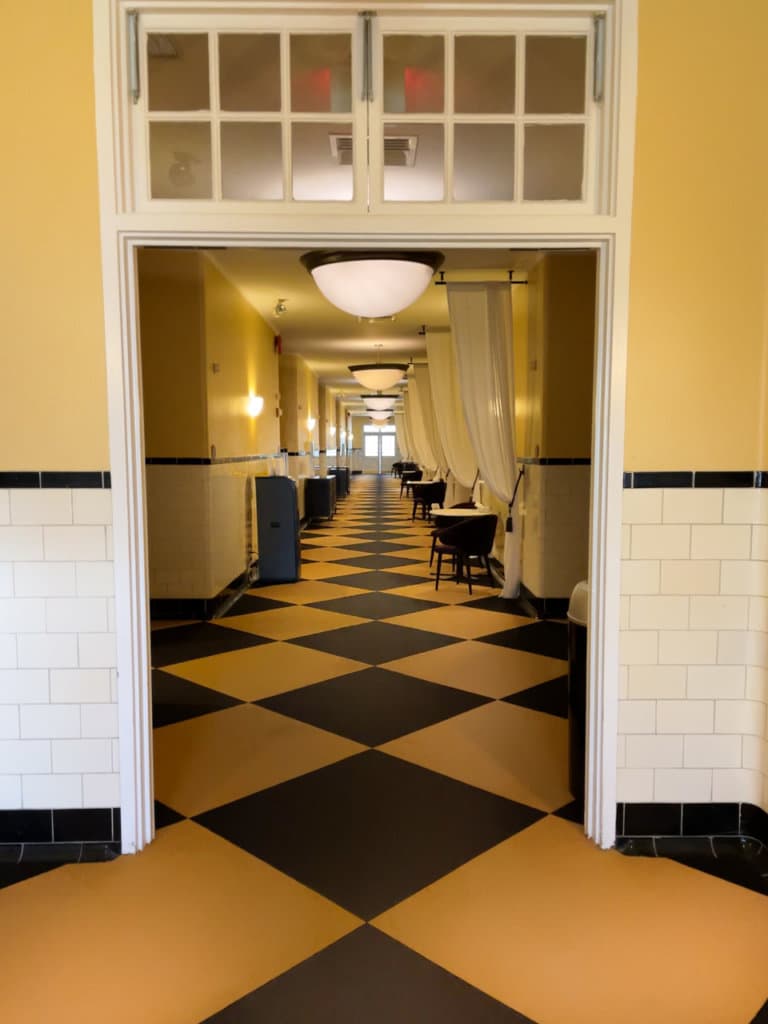
Today, the best place to “take the waters” as Aunt Evelyn might have is at Roosevelt Baths & Spa, a resort that offers various hydrotherapy and massage treatments. The spa was established in 1935, long after Tess and Aunt Evelyn’s visit, but the architecture and décor do evoke the sense of a long-gone era. And unlike in 1926, today we can visit a spa purely for self-care, rather than relying on doctor’s orders.
My personal experience at Roosevelt Baths & Spa included a 40-minute soak in a warm bath that was loaded with natural minerals. The treatment rooms are made for one so I had total and complete privacy.
- Roosevelt Baths & Spa: 39 Roosevelt Dr., Saratoga Springs, NY
We have more in common than I realized! Thank you for doing such a wonderful job connecting the Galliano Club books to their birthplace. I can’t wait to share it with friends and family!
We do have a lot in common. Our grand- or great-grandparents probably crossed paths at some point in Rome in the past! I had a lot of fun with this.
Thank you for bringing the books to modern-day life. I love following a map when I read, and I charted many locations like the rum-running trip and Saratoga Springs. But it never occurred to me to look for businesses that are still open. If I ever get up there I will check them out.
Embarrassing fact: the books were so real to me that I once put “Lido” into Google Maps. Argh.
I know, Lido was so real–I hated to leave when I finished the books!